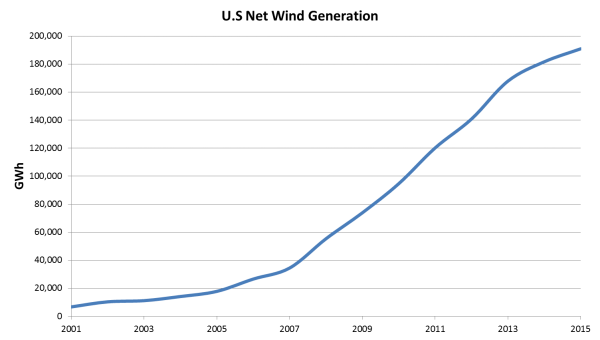Have questions or need help? Give us a call: 1-(888)-364-9259
Electricity - Catching the wind. Harnessing the power of the wind is not a new concept. Windmills have played a role in improving our lives for the better part of two thousand years. Windmills enabled our ancestors to mill grain and pump water for their livestock. While wind energy is still widely used to pump water, it is becoming more commonly used to generate electricity. Wind-powered turbines allow consumers to choose electricity plans backed by clean wind generation.
The growth of wind generation in the United States over the past 15 years has been amazing. According to the U.S. Energy Information Administration (EIA), wind turbines generated 6,737 GWh of electricity in 2001. In 2015, this number increased to 190,927 GWh. That represents more than a 2700% increase in just 15 years. Wind energy has become a significant part of the generation mix. It has also reduced the amount of fossil fuel generation needed to meet our electricity needs.

Wind-powered turbines are not evenly distributed across the country. In 2001, California was responsible for 52% of the nation’s wind electricity generation. Texas, Minnesota, and Iowa combined for another 38% of our national wind power. This means that 90% of wind generation that year was concentrated in just four states.
The rapid growth in wind generation has changed things up a bit. In 2015, Texas accounted for 24% of wind generation and was the leading wind power producer. Although California increased its wind generation by 250% from 2001 to 2015, it now only accounts for 6% of the nation’s wind energy. Wind generation has diversified to such a degree that it now takes seventeen states to account for 90% of the power produced. Not only has the amount of wind generation skyrocketed, it now covers a broader geographic area.
| 2001 GWh | 2015 GWh | |
| Texas | 1,188 | 44,959 |
| Iowa | 488 | 17,878 |
| Oklahoma | 0 | 14,018 |
| California | 3,500 | 12,228 |
| Kansas | 40 | 10,927 |
| Illinois | 0 | 10,733 |
| Minnesota | 897 | 9,797 |
| Colorado | 49 | 7,441 |
| Washington | 0 | 7,101 |
| Oregon | 89 | 6,675 |
| North Dakota | 0 | 6,530 |
| Michigan | 0 | 4,778 |
| Indiana | 0 | 4,516 |
| New York | 21 | 3,956 |
| Wyoming | 365 | 3,768 |
| Pennsylvania | 11 | 3,352 |
| Nebraska | 3 | 3,154 |
| South Dakota | 1 | 2,481 |
| Idaho | 0 | 2,457 |
| New Mexico | 0 | 2,067 |
| TOTAL | 6,652 | 178,816 |
Also, it is interesting to note that the state of Washington, lacking any significant wind generation fifteen years ago, produced more electricity from wind in 2015 than the entire nation did in 2001.
Twelve states and the District of Columbia did not report producing any meaningful amount of electricity from wind generation in 2015. The states were: Alabama, Arkansas, Connecticut, Delaware, Florida, Georgia, Kentucky, Louisiana, Mississippi, North Carolina, South Carolina, and Virginia.
Some of these states have significant hydropower generation. Wind power has not always been able to compete economically with hydropower. Yet, not every state has favorable conditions for large-scale windfarms. Each state is unique and it takes a special combination of regulatory, geographic, and power grid factors for wind generation to make sense.
Where is wind generation heading? Wind currently ranks behind hydropower as the second largest source of renewable energy. The EIA projects wind will overtake hydropower in 2038 and dominate the renewable energy market. For consumers, this means greater access to renewable energy plans. It should also translate into reduced premiums for green electricity over standard generation.